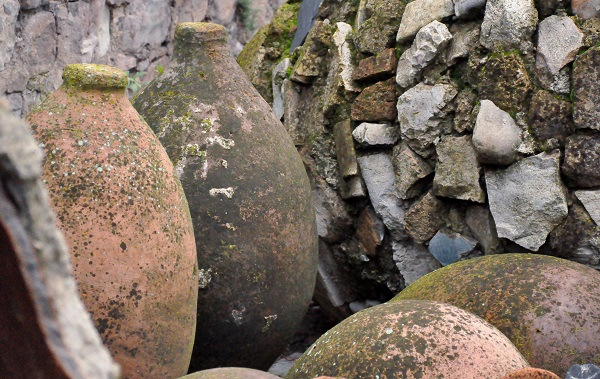
by Magnus Reuterdahl
One on the most exciting places we visited was the Alaverdi Monastery and their wine cellars. Some places just moves you, this such a place – this place combines my interest for archaeology, history and wine. Our guide is Father Gerasimi Otarashvili.
While walking into the monastery it feels like taking a step into history, not just the fact the the females of our group needs to use skirts and cover their hair, but the buildings, the scene, the area has that feel that slows down time. That kind of serenity and quietness that often hits you when entering a church, a temple, a mosque, a synagogue or another religious setting.
In the monastery the monks make qvevri wines much the same way as they have done since the 11th century. The history of the Alaverdi monastery and cathedral is located in the Alazani river valley, ca 18 km from the town of Telavi, near the village Alaverdi, is older. It stretches back to the middle of the 6th century when the monastery was founded, by on of the thirteen Sirian fathers Joseph (Ioseb Alaverdeli), who also is said to be buried here. The monastery was turned into the episcopalian Cathedral during the 11th century and from that time there are archaeological evidence of wine making. The Cathedral was built on top of an older church.
Qvevri wine are made in a traditional way. The grapes are pressed by foot in a narrow stone or wood lagar after the pressing the spontaneous fermentation starts within three days and lasts for three to four days. The fermentation is done within the qvevri. After the spontaneous fermentation the qvevri is closed. The wine is usually left on the skins for five or six months. Micro-oxidation happens through the clay of the qvevri and the temperature is kept by the earth surrounding the qvevri.
Archaeological excavations shows that there was a working winery in the monastery grounds during the 11th century with qvevris (clay vessels) that could ferment 2000 and 4000 litres. During the excavation more than 40 qvevris was unearthed, this suggests that they produced ca 70 tonnes of wine a year.
During the Soviet Union days the government to eradicate the tradition of qvevris and they passed a strict law to abolish qvevri production. In spite of this the knowledge was preserved. In 2006 began production again. Today they make qvevri wine as well as traditional European style wine.
We tried three wines, all very good and interesting.
Alaverdi Monastery Cellar Rkatsiteli 2010
The scents is deep and long with lots of dried fruit, nuts, honey and capers. There is also fresh notes with flowers and pears.
It’s young and fresh with fantastic tannins and a great acid. The mix of soft oxidation, dried fruits, apricot and apples, spices and the fresh notes of flowers and pears that gives a really exiting wine – which I would love to age. Its elegant and complex, its one of the best orange wines of the trip.
Alaverdi Monastery Cellar Kisi 2010
For a qvevri wine this very fresh, with peach and citrus notes, lots of minerals and fantastic dryness. Unfortunately this is served a little to cold, and as it is cold outside its difficult to heat it – I would love to taste this again – lots of promise and elegance.
Alaverdi Monastery Cellar Saperavi 2011
The red qvevri wines was all new to me and they really shine, the ones I tasted really makes you long for steak. This is a complex spicy wine with a fantastic fruit, cherry, blue berries, blackberries and some red forest berries as well as flowery rose tone, a long after taste and firm tannins. Age for a few years and this is perfection – I really love this.






